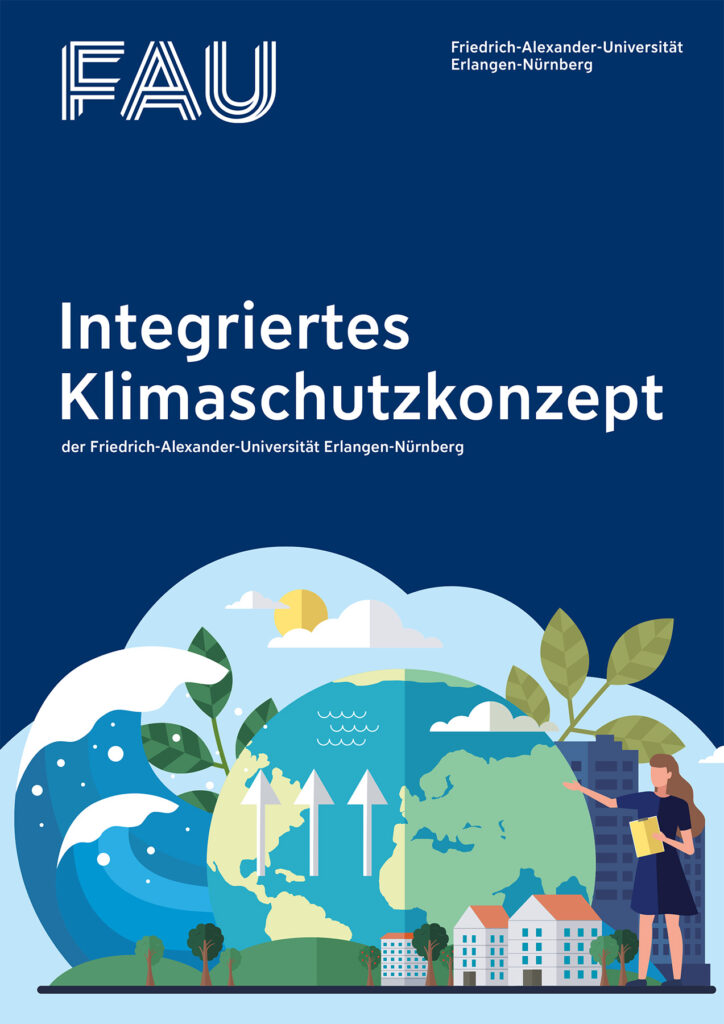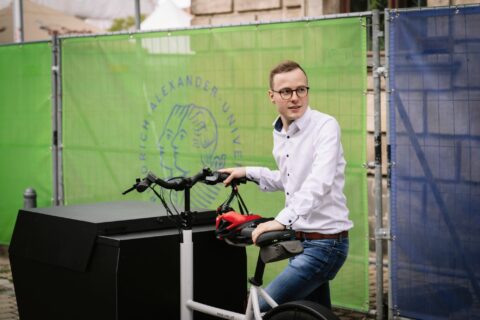How FAU is becoming a pioneer for climate action
How can FAU reduce its greenhouse gas emissions and set an example for climate action? How exactly can each individual member of FAU play their part? The answers are in the first Integrated climate action plan of Friedrich-Alexander-Universität Erlangen-Nürnberg, which has just been published.
New: Climate action plan at FAU
The Integrated climate action plan is intended to act as the basis for the systematic and structured reduction of greenhouse gas (GHG) emissions at FAU, which is one of the largest research universities in Germany and therefore has the corresponding number of sources for Co2 emissions. “Our size alone places us in a position of special social responsibility, and we are therefore keen to set an example when it comes to climate action,” says David Brenner, who is responsible for climate action at FAU. The business and economics graduate has been working in the Green Office at the University since January 2023 and was instrumental in drafting the Integrated climate action plan of Friedrich-Alexander-Universität Erlangen-Nürnberg.
Climate neutral by 2035

First of all, the concept outlines the current status of GHG emissions at the University. From direct emissions from burning fossil energy sources to indirect energy-related emissions connected to electricity and heating to other indirect emissions that arise for example from purchasing or business journeys. Altogether, FAU generated total emissions amounting to approximately 48,400 tons of CO2 equivalents in 2022. That is the conclusion reached after Brenner’s meticulous analysis of all available facts and figures. “Our annual electricity consumption alone is of the same magnitude as 45,000 single-person households,” the climate action manager reports. “Bearing this in mind, we changed several years ago to 100 percent green electricity, which allowed us to reduce our emissions of greenhouse gas equivalents on the balance sheet by approximately 27,8000 tonnes CO2 equivalents. Recently, we have also been able to take steps in the right direction by keeping energy consumption in check and by increasing the number of solar panels we have.”Important successes that Brenner is clearly pleased about, as he is an avid supporter of climate action. He nearly always cycles or takes public transport, no matter whether for work or leisure, and hopes that as many other people as possible will follow his example. Especially when you consider that the majority of the University’s GHG emissions are caused by FAU members commuting. Commuting accounted for just under 21,400 tonnes of CO2 equivalents, or 44 percent of emissions. Heating comes in at second place, accounting for 17,900 tonnes of CO2 equivalents, or 37 percent of emissions.David Brenner explains the University’s ambitious goal: “In the coming years, we must significantly reduce all greenhouse gas emissions at FAU, as we hope to be climate neutral by 2035.” “Our focus is on the most cost-effective options for reduction, as seen for example in our campaign #FAUspartenergie, with practical tips for saving energy in the office, in research and in teaching.”
A joint effort
The Integrated climate action plan suggests a total of 84 climate action measures. The Green Office has drawn up the catalog of measures over the last one and a half years, integrating a wide variety of ideas from FAU members. FAU members took part in workshops and made the most of other formats for making their voice heard, and submitted more than 250 suggestions for climate action measures. The climate action manager is pleased with the response, “the topic is clearly very important to a lot of people,” and he is confident that “more people will become actively involved if we improve the framework conditions for climate-friendly behavior.” This is ultimately the aim of the 84 measures outlined in the Integrated climate action plan. They come from 13 diverse fields of action ranging from waste and wastewater to heating and cooling, with mobility and heating having the highest priority. “We also want to make progress in the area of electricity,” Brenner explains. “We will soon be able to start operating the largest photovoltaic system at FAU to date on the roof of the Institute of Microelectronics, which is capable of generating roughly 160,000 kilowatt hours of electricity from solar power. That is equivalent to the consumption of 60 households, and with the new system we will save more than 60 tonnes in greenhouse gas emissions.” Plans are also in the pipeline for an even larger photovoltaic system on the planned new multistory car park at Erlangen Campus (South). In addition, plans are in place for installing more than 100 charging stations for electromobility there, in a bid to “create better framework conditions for climate-friendly behavior.” This also includes measures such as “attractive options for parking bikes” and “reducing consumption of paper and resources by encouraging digitalization” or “providing information on the topic of sustainability in laboratories.”
Climate action now and in the future
At least 17 measures from the Integrated climate action plan should be implemented in the next three years FAU has applied for follow-up funding for climate action management within the context of the National Climate Initiative (NKI) from the Ministry for Economic Affairs and Climate Action. Climate action management is to be continued under the auspices of the Green Office, encouraging climate action and sustainability to become an intrinsic part of the institution. In addition, progress is to be monitored on an ongoing basis and there is to be regular communication about climate action measures.
 Download Climate action plan
Download Climate action plan
- Integrated climate action plan of FAU (short version, English)
- Integrated climate action plan of FAU (long version, accessible, German)
- Integrated climate action plan of FAU (short version, German)
Further details about climate action management at FAU is available on the Green Office’s website:

